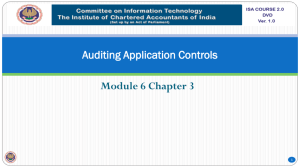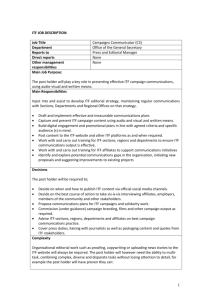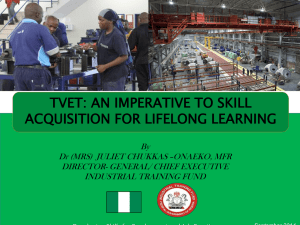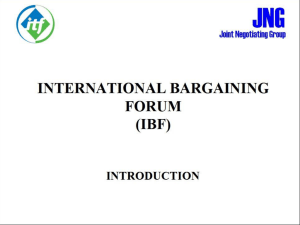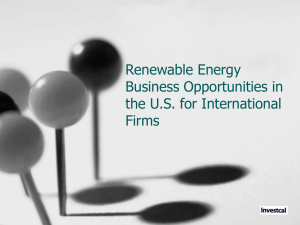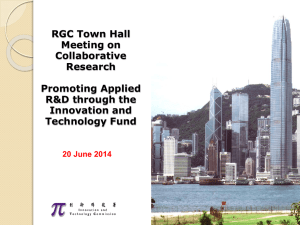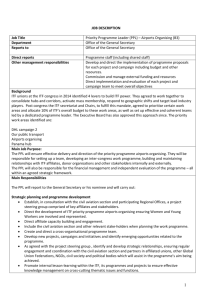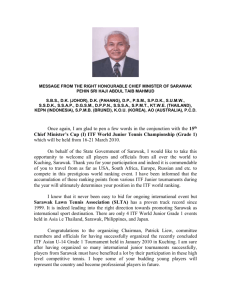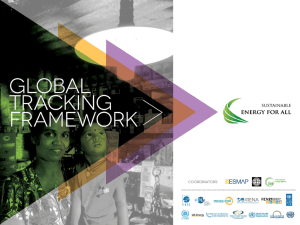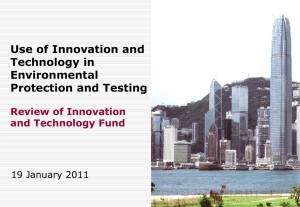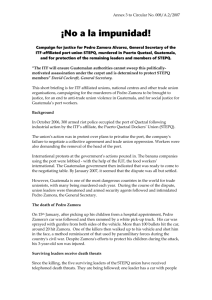EU Agenda for change
advertisement
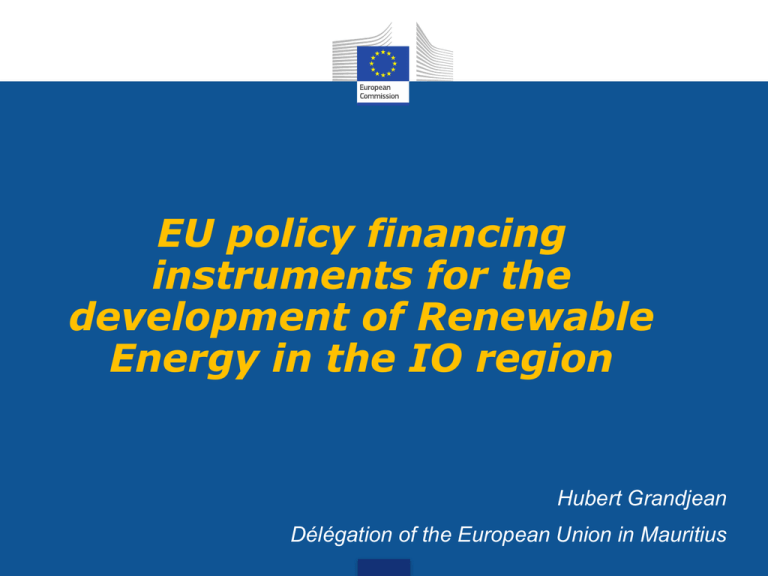
EU policy financing instruments for the development of Renewable Energy in the IO region Hubert Grandjean Délégation of the European Union in Mauritius POLICY (1/3) • EU Energy Initiative (EUEI) launched at the 2002 World Summit on Sustainable Development held in Johannesburg. • Joint commitment by EU Commission and Member States to contribute to providing access to energy necessary for achieving the MDGs, particularly but not exclusively that of halving the number of people in extreme poverty by year 2015. 2 POLICY (2/3) • EU Agenda for change : increasing the impact of EU development policy; adopted by EU council in May 2012. • Sets new directions on how to address poverty eradication and development aid challenges • Also looking ahead to Rio+20 outcomes and post2015 development agenda 3 POLICY (3/3) • EU Agenda for change : priorities • 1) Promotion of human rights, democracy, rule of law, and good governance • 2) Promotion of inclusive and sustainable growth: • Inclusiveness focused primarily on social protection, health and education, • Support notably to sustainable agriculture and energy, incl. natural resources management, key to transition to green economies, and private sector as vector for development 4 INSTRUMENTS (1/5) • ACP-EU Energy Facility (EF) created in 2005 to respond to EUEI objective in the ACP region. • Interventions : • 1) Expansion of national power grid and distribution network • Examples: Use of the Cotonou investment facility by IEB in Uganda: loan to a private concessionaire on loss reduction and access (~ €100 million); Mozambique (public financing) • 2) Electrification in connection with new transmission lines • Example: Caprivi interconnector, financed by the ITF in Tanzania, includes a rural electrification component 5 INSTRUMENTS (2/5) • EF interventions: • 3) Proving funds to facilitate higher rate of customer connections / mechanisms to reduce costs / facilitate payment.. • Example: Discount in Burkina; Revolving Fund in Kenya (AFD) allowing more affordable connection to customers (fee paid over longer period) • 4) Working through financial intermediaries to support SMEs • Assist accessing to international financing for small/medium scale initiatives (example: Africa Sustainable Energy Facility project by IEB; credit line awarded to DBS in Seychelles) 6 • 5) Working through Rural Energy/electricity Agencies/Funds INSTRUMENTS (3/5) The SE4all - Sustainable Energy for All - initiative launched by the UN in 2012 is supported financially by the EU to the tune of 400 million Euros Targets by 2030: • Universal access to energy (target: 500 more million people) • Improved energy efficiency • Enhanced deployment of renewable energy 7 INSTRUMENTS (4/5) EU financial support to SE4all initiative is directed through several financial instruments: 1) EU-Africa Infrastructure Trust Fund (ITF) managed by EIB; regional and national infrastructure only in the scope of SE4all 2) European Development Finance Institutions EDFIs (IEB,AFD, KFW, …) 3) GEEREF (Global Energy Efficiency and Renewable Energy Fund); fund-of-funds for small/medium sized projects 4) EU energy facility (EF) envelope for calls for proposals managed by EU Commission (last call: end 2012) 8 INSTRUMENTS (5/5) Others tools: EU Technical Assistance Facility on energy access for the S4A initiative (47 M. EUR): to target countries for increasing admin./technical capacity and implement reform policies. Direkt –Small Developing Island Renewable Energy Knowledge and Technology Transfer Network – a project of cooperation between universities (Germany, Fidji, Mauritius, Barbados, Trinidad Tobago) funded by EU under the ACP science and technology programme. 9 The blending of different types of supports for greater leverage 1. Direct investment grant and interest rate subsidy grants, decrease the investment cost for sponsors. 2. Technical assistance accelerates projects and improves quality, efficiency and impact. 3. Risk capital (i.e. equity & quasi-equity) mobilises additional financing (presently MSME only). 4. Guarantee mechanisms reduces risk and improves access to finance. 10 The ITF Infrastructure Trust Fund: leverage and main EFI users 2007-12 76 approved applications supported with an expected total cost of > €8.5 billion • PFG's resources leveraged > € 2.0 billion ITF resources allocated to approved applications > € 390 million LEVERAGE PFG resources/ ITF grant* Total project cost/ ITF grant* * Investment phase only 7.1 Lead EFI financier (based on cumulative grant value approved by ITF) 12.5 11 ITF overview 2012 ITF overview ITF approvals €approvals million 2007 2008 2009 2010 2011 2012 4 4 11 19 19 19 2007 15.3 2008 47.8 31.5 2009 110.9 83.7 94.5 2010 2011 2012 ITF signatures €projects million 2007 2008 2009 2010 2011 2012 2007 6 1 6 15 1 2008 59.5 2.8 2009 12.1 86.4 2.4 2010 2011 2012 ITF disbursements €projects million 2007 2008 2009 2010 2011 2012 0 5 12 14 30 23 2007 2008 1.1 22.4 22.4 8.4 2010 17.5 34.4 2011 2012 Cumulative approvals 12 Example1: Ouarzazate solar power plant (NIFENPI countries) Direct investment grant Part of the Moroccan Solar Plan. If fully developed (2GW target capacity), the largest solar power plant in North Africa. Project promoter is the Moroccan Agency for Solar Energy (MASEN). Independent power producer (IPP) to implement the project is determined by MASEN through competitive bidding. NIF direct investment grant to bring down the cost of electricity during the initial stage of the project. Total project volume: approx. €807 million Grant contribution: €30 million Involved FIs: EIB, AFD, KfW, IFC, WB 13 Example 2: Africa Sustainable Energy Facility Guarantee mechanism Increasing the role of the private sector in financing climate change activities by promoting climate finance through local financial intermediaries EU grant resources (up to €5m) can be used to guarantee 50% of the first-loss on a portfolio of new loans for energy efficiency and renewable energy projects originated by local (private sector) finance institutions, who retain the remaining risk. Combined with €3M TA program to support local project developers and build local finance institution capacity. Total project volume: up to €50 million Involved FIs: EIB, IFC 14 Example 3: Seychelles East Africa Submarine Cable (SEAS) Grant IRS Mauritania Submarine Cable SEAS cable link directly into a landing station of ZANTEL in Dar es Salaam, from where other international fibre systems are accessed. Total project cost is €26.6 M. Financing of EIB : loan of €8 M, plus ITF grant of € 4M financing GoS equity stake in the cable company created and held by the two main telecom operators and the GoS. The model allows for social benefits in terms of ICT access for schools, hospitals.. Similar project in Mauritania, where the grant was used as an Interest Rate Subsidy IRS to soften EIB loan to the Government. 15 Other blending mechanisms GEEREF : Global Fund of funds catalyzing investments for energy efficiency and renewable energy projects, 2 investments in Sub Saharan Africa European Development Financing Institutions EDFI €50M first loss guarantee mechanism in the context of SE4all (under negotiation) 16 Geothermal Risk Mitigation Facility (GRMF) To encourage public & private investors to mobilize & provide funds for development of geothermal power plants in East Africa Pilot Countries: Ethiopia, Kenya, Rwanda, Tanzania, Uganda; Additional countries next round: Burundi, Comoros, Djibouti, DRC, Eritrea & Zambia Geothermal Risk Mitigation Facility 30 Mio. € Surface studies “GRMF” Database Private/ Public Investors Drilling 20 Mio. € EU- ITF AUC Regional Geothermal Coordination Unit (RGCU) 17 The EU regional programme for Renewable Energy and Energy Efficiency Improvements to IOC member states (1/3) Financed by EU (10th EDF) to the amount of 15 million Euros Status: Financing agreement signed with IOC in June 2013; Forecast start activities: March 2014; max duration 4 years; Expressions of interest on going for the technical Assistance; Objective: Establish conditions for the development, investment and sustainable management of renewable energy and improvements in efficiency of energy use in IOC region Five expected results: 1) A regional IOC strategy focussed on HR development and institutional building is agreed and implementation started 18 EU Regional programme for RE and EE Improvements to IOC member states (2/3) Expected results (cont.): 2) A RE&EE promotional campaign and advocacy plan is developed, agreed and implemented 3) The regulatory and business environment for RE based gridconnected electricity generation has been improved; wind and solar resource data bases have been further developed 4) Government agencies and private investors have developed their capabilities to design, engineer, construct and operate decentralised electric power / energy systems based on renewable energy 5) Energy efficiency standards and labels have been developed and implemented in most IOC member countries a) for all categories of buildings and b) for household appliances and equipment with major impact on electricity consumption and peak load 19 EU Regional programme for RE and EE Improvements to IOC member states (3/3) Implementation - Investigating the use of available policy and financial instruments cited above so as to generate leverage and co-financing/ blending opportunities, in particular but not limited to the scope of the call for proposals scheduled in project activity 4. - Promoting partnerships and networking at an early stage among all stakeholders including in particular the private sector. - Promoting coordination mechanisms at national/regional levels and with other donors in the energy sector so as to create synergies. - Targeting activities and results with high impact for the sector and the countries with due consideration to EU and SE4A priorities. 20 Thank you Délégation of the European Union in Mauritius

